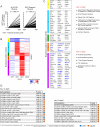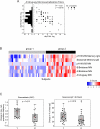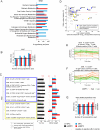Global analyses of human immune variation reveal baseline predictors of postvaccination responses
- PMID: 24725414
- PMCID: PMC4139290
- DOI: 10.1016/j.cell.2014.03.031
Global analyses of human immune variation reveal baseline predictors of postvaccination responses
Erratum in
- Cell. 2014 Jul 3;158(1):226
Abstract
A major goal of systems biology is the development of models that accurately predict responses to perturbation. Constructing such models requires the collection of dense measurements of system states, yet transformation of data into predictive constructs remains a challenge. To begin to model human immunity, we analyzed immune parameters in depth both at baseline and in response to influenza vaccination. Peripheral blood mononuclear cell transcriptomes, serum titers, cell subpopulation frequencies, and B cell responses were assessed in 63 individuals before and after vaccination and were used to develop a systematic framework to dissect inter- and intra-individual variation and build predictive models of postvaccination antibody responses. Strikingly, independent of age and pre-existing antibody titers, accurate models could be constructed using pre-perturbation cell populations alone, which were validated using independent baseline time points. Most of the parameters contributing to prediction delineated temporally stable baseline differences across individuals, raising the prospect of immune monitoring before intervention.
Copyright © 2014 Elsevier Inc. All rights reserved.
Figures







References
-
- Benjamini Y, Hochberg Y. Controlling the False Discovery Rate: A Practical and Powerful Approach to Multiple Testing. Journal of the Royal Statistical Society Series B (Methodological) 1995;57:289–300.
Publication types
MeSH terms
Substances
Grants and funding
LinkOut - more resources
Full Text Sources
Other Literature Sources
Medical
Molecular Biology Databases

